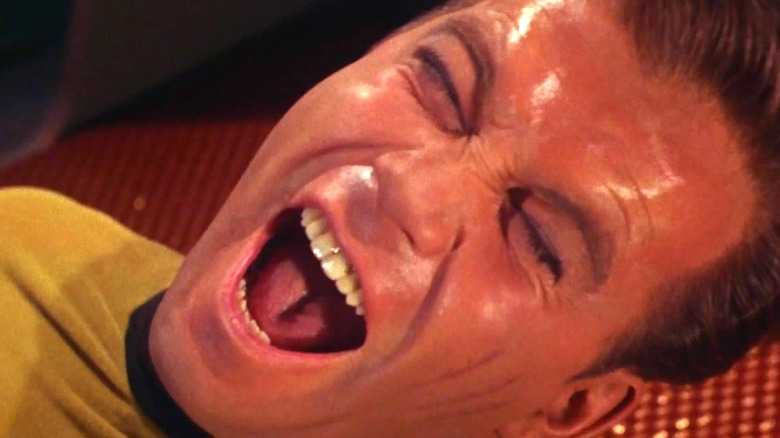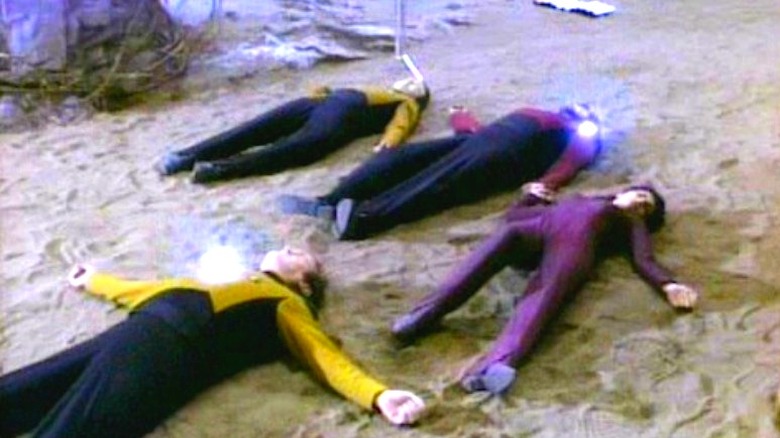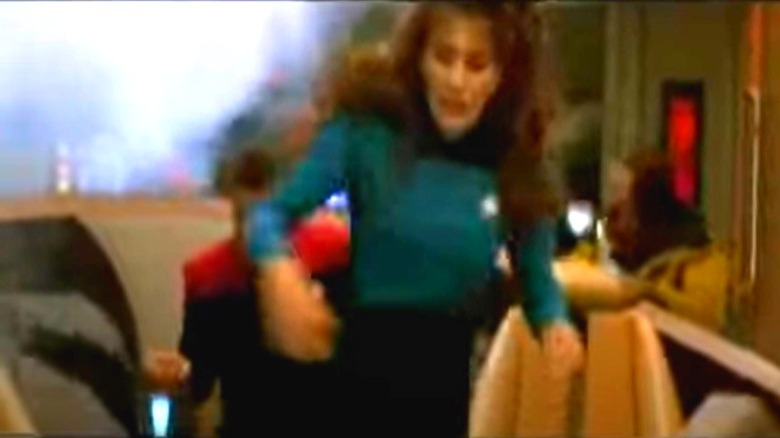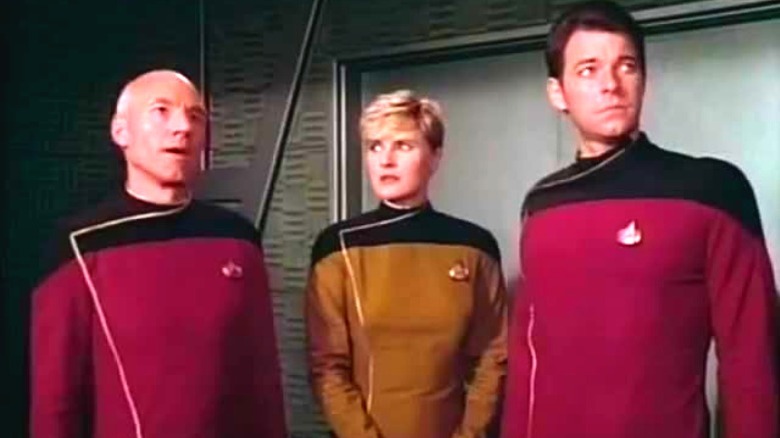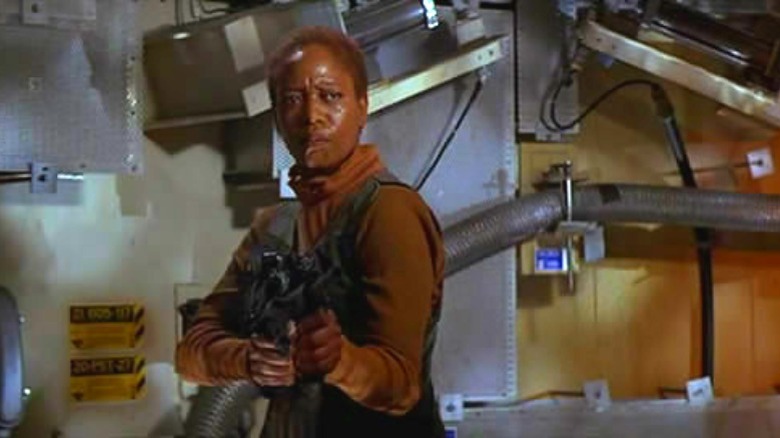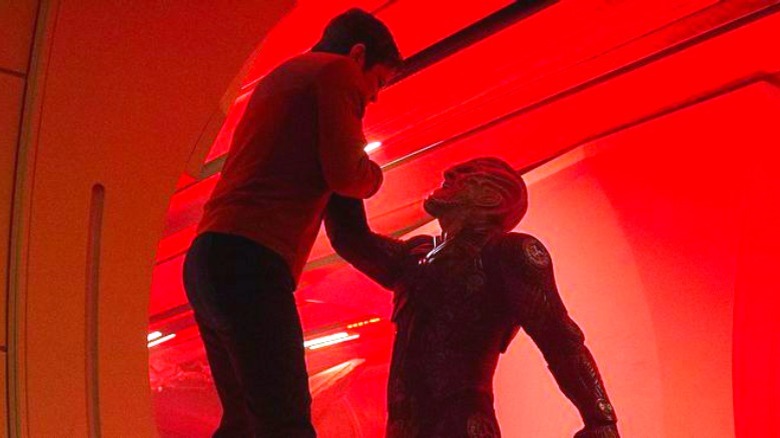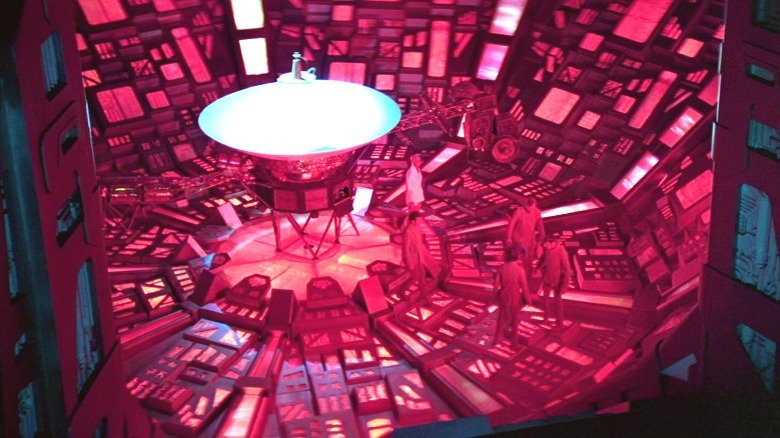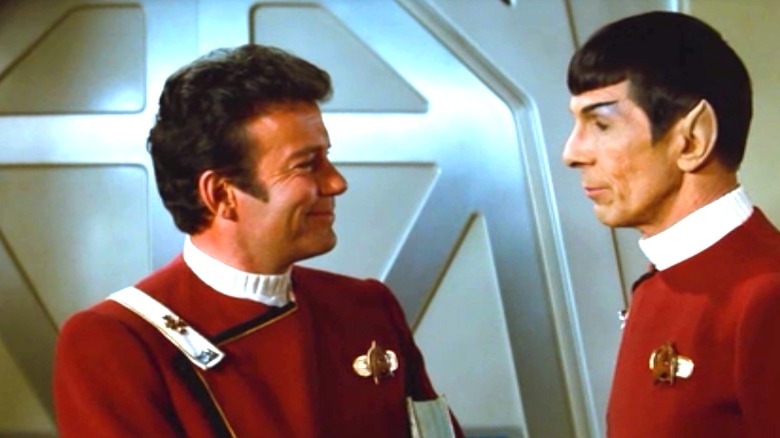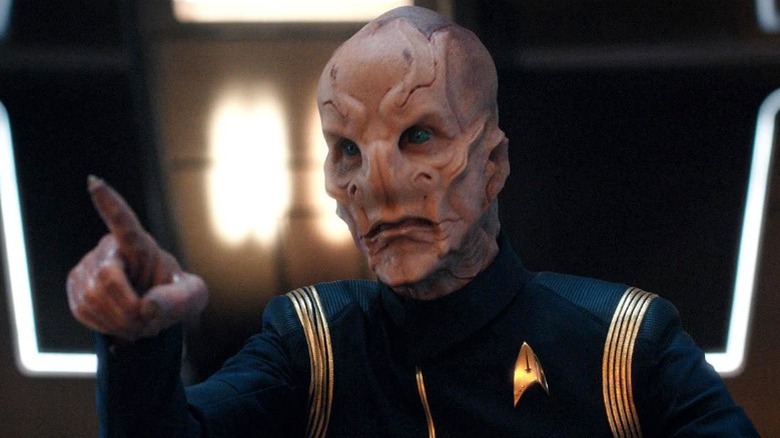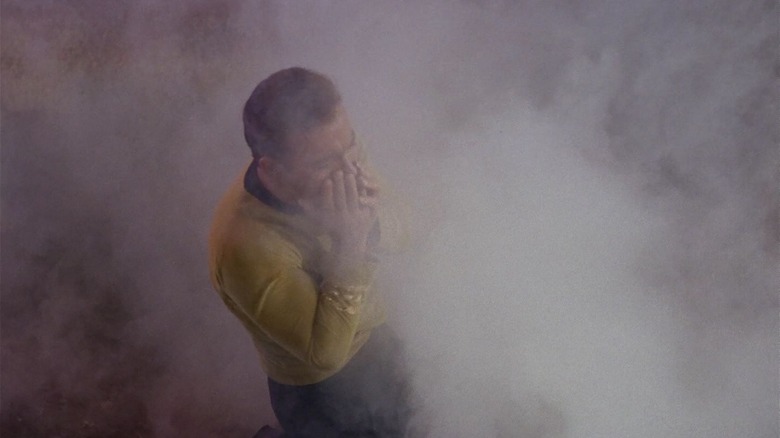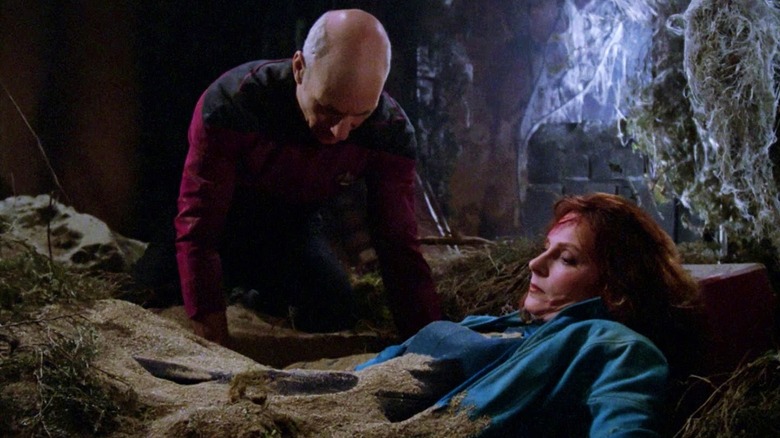Injuries That Happened On The Star Trek Sets
If you ever meet a true Trekkie, two things will happen. One, they will tell you it's actually Trekker, thank you very much, and two, they'll be able to tell you just about everything about the many TV show and movie versions of their beloved universe. How many episodes of the original series saw Captain Kirk shirtless? Thirteen (out of 79 episodes, and compared to Spock's one). The name of Captain Janeway's dog? Mollie. Who's better, Kirk or Picard? That's the one you ask so you can run away while they try to answer the unanswerable question.
But that's all on-screen facts. Behind the scenes stuff might be a little more obscure. In some cases, though, things that go wrong on set end up affecting or adding to what you see on screen. This is especially true when it comes to injuries. While any series that's been around as long as Star Trek is going to have seen some painful accidents, there aren't too many that have come to light over the years, making the ones we do know about all the more notable.
The shows and movies might have sick bays that can cure almost anything (especially if you are a main cast member), but back here in the 20th and 21st centuries, the actors are stuck with our crude medical knowledge when they get a Star Trek-related booboo. Ranging from the minor to the embarrassing to the quality-of-life-altering, here are injuries that happened on the Star Trek sets.
Marina Sirtis thought she could handle a simple stunt
Somehow, Marina Sirtis, who played Counselor Deanna Troi on "Star Trek: The Next Generation," ended up in a he-said, she-said over just what led up to her getting injured while doing a stunt in the Season 5 episode "Power Play." Based on interviews they gave separately, it's clear that Sirtis and her director have very, very different memories of what occurred on set that day.
As Sirtis remembers it, the director approached her and asked if she wanted to do her own stunt. She was hesitant, asking what it was, and was assure it would be extremely simple, that she "basically just [had] to fall over." The director, on the other hand, says that Sirtis "always wanted to do her own stunts" and that even though he had a stunt double on hand, Sirtis wanted to do this one herself. Regardless, Sirtis should have bailed once she realized she was the only actor shooting the scene, with all four of her male co-stars replaced with stuntmen. She did the stunt anyway, falling backwards, and injured her tailbone so badly that she reportedly "couldn't walk for several weeks," according to "Science Fiction Television Series, 1990-2004: Histories, Casts and Credits for 58 Shows."
Although, despite that dramatic result, it turns out her injury was not as bad as you might have heard. When one Twitter user asked Sirtis in 2013, "Didn't you once break your tailbone in a TNG stunt?" she replied, "Hurt not broke."
Marina Sirtis burned her bottom in 'Star Trek: Generations'
Poor Marina Sirtis' bad luck on Star Trek sets didn't end with the show. Movies have much bigger budgets, so theoretically they should have the money to be safer working environments. But even when everything goes right, small unforeseen issues can arise. Especially when explosions are involved.
According to Entertainment Weekly, in 1994's "Star Trek: Generations," Sirtis' character Deanna Troi gets one of the biggest honors on the brig: she gets to pilot the Enterprise. Sure, it's not the best situation, considering the ship is under attack, but Troi bravely leaps (literally) to the rescue. Unfortunately, right before she does, the Enterprise is hit, and part of the brig dramatically explodes. Even though experts on set would have prepped the controlled explosion so no one would get hurt, brave Troi accidently ended up with some battle scars.
"The explosion left embers on the seat," says Sirtis. "I sat down and it set my bottom on fire. There I was, hopping up and down, going 'Ow! Ow! Ow!'" She might not have been physically injured, not needing any sort of medical treatment and continuing to shoot the scene, but the emotional scars were unavoidable. "On the next take, I went over to the chair, and in what [was supposed to be] a life-or-death situation, I stopped and wiped down the seat ... It gave [the crew] a good laugh." In the film, the shot cuts off before we see Troi sit down, so neither her painful reaction nor her self-preservation made the final cut.
The costumes on 'Star Trek: The Next Generation' caused serious issues
There are plenty of obvious dangers on the set of a TV show. There are dangerous stunts, exploding lights, tripping over the wires running everywhere. But if you were an insurance agent, standing in the middle of all the action and trying to write down everything that could be a possible liability, you'd be there a long time before you got to the thing that broke people on the "Next Generation" set: their costumes.
The uniforms worn in the first season of the show were notoriously terrible. While the recent films had put the original series cast in boxier uniforms, this time the designer went with something a lot more streamlined: spandex. This was a problem if an actor had just eaten a big meal, but it was even worse for Patrick Stewart, who actually found himself in agony from his.
He told Newsweek, "I came to loathe [the uniform]. We actually got rid of it after the second season thanks to my chiropractor, who said if they don't take you out of that costume, we are going to slap a lawsuit on Paramount for the lasting damage done to your spine ... They were made from Lycra and one size too small. The producers wanted to have a smooth, unwrinkled look. It put a terrible amount of strain on the shoulders, neck and back." And when Captain Piccard tells you to make is so ... much less painful to wear the costume, you do it.
Alfre Woodard still has the scars from her injury
Alfre Woodard is an absolute acting legend. She starred in "Star Trek: First Contact" as Lily Sloane and the Hollywood Reporter called her "the heart of the film." In an interview with Collider (via CheatSheet) she said she loved working on the film and with director Johnathan Frankes, even though she still has visible scars on her arms from the experience.
She explained that in a scene with an explosion, "It was me and [James Cromwell] and probably 200 stunt people when the explosion happened ... and when it happened, the explosion was so intense that it just knocked us on our butts ... My arms were bleeding, and the skin was gone. I ran up to Jonathan and I said, 'Jonathan, I messed up the costume and my arms are bleeding,' and he said, 'That's okay, we got the shot!'" Then he turned and walked away.
While that might sound really harsh (okay, it is), there were no hard feelings, since Woodward and Frankes go way back, and have shared a special connection since they were young actors in Hollywood. Woodward told the Hollywood Reporter that once when they were hanging out, "I was talking about what my godmother meant to me. His eyes were moist, and he said, 'I don't have a godmother.' I said, 'Are you kidding?' Then he looked at me and said, 'Will you be my godmommy?'" Great job, Frankes, you scarred your godmother for life.
Idris Elba gave Chris Pine a perfectly timed black eye
Casting Idris Elba in anything is a great idea, but it was especially exciting when he was added to the Star Trek universe as baddie Krall in "Star Trek Beyond." While he fit in with the cast immediately, he still found it kind of scary to be a big, important role in the film when surrounded by a cast and crew that were already used to working together on the first two installments.
But Elba got comfortable eventually, maybe a bit too comfortable. Elba told the Hollywood Reporter, "We had laughs. Chris [Pine (Captain Kirk)] and I had laughs, and then I gave him a black eye ... we were doing a fight scene, and he got a bit cheeky, and I was just like pow! ... I didn't mean to do it, but Chris was quite proud of it."
So whose fault was it? It sounds like director Justin Lin takes responsibility for the injury to Chris Pine's beautiful face. Lin explained, "This cast goes all out, and I like to challenge them. We were shooting this third act fight, and I kept pushing to get the right angle, to the point where Chris just got hit." The director wasn't mad, in fact, if anything, he thinks the visible injury added to the film. Because of the filming schedule, the real black eye just added to Kirk's character. "Continuity-wise, it worked out. That black eye played so well in the rest of the movie."
The 'Star Trek: The Motion Picture' set was a deathtrap
The original Star Trek TV show's final episode aired in June 1969. But for years, there were plans to bring the actors back for ... something. What that something was kept changing, until finally, at a press conference in 1978, "Star Trek: The Motion Picture" was announced, according to Den of Geek. While fans might have been thrilled, for everyone involved in the production, things seemed to go downhill from there.
The film already had a release date, but there was no film, so director Robert Wise had a year to make one happen and get it into theatres. Leonard Nimoy almost didn't agree to do the film for a variety of reasons, including the fact he was in the middle of suing Paramount. The screenplay kept being rewritten. And sets that had been built for a possible new Star Trek TV show had to be quickly rebuilt to look good on the big screen.
That last one might have been a mistake, because at least one set piece seemed to want to kill someone. "We had a number of injuries," Wise said. "A gigantic set at the climax was made out of lights, panels, and plastic forms. Any number of our people fell through it. Finally, they put up a board to keep score: which departments fell through the most – electricians, actors, artists? One electrician, Tiny, fell and sustained a very serious shock. A grip launched himself to knock Tiny loose from the cable he was holding."
William Shatner still had an issue decades later
The injury William Shatner suffered might not have been visible to anyone else, but it was probably the one with the worst long-term consequences.
In 1997, after a doctor's appointment at the University of Maryland Medical Center, Shatner held a press conference. (A reporter who covered it for the Baltimore Sun called the security situation there as comparable to that required for a visit from the pope.) Shatner told the assembled press, "Some years ago, we had an explosion on the set of one of our 'Star Trek' movies," Shatner said. "[Leonard Nimoy and I] both got this ringing in our ears, and it never really went away ... It's like a radio left on, but just the static. And you can't turn it off ... I thought I couldn't take it anymore."
Shatner was suffering from tinnitus, but for years he never heard that word, from doctors or anyone else. Tens of millions of people suffer from it, but back in the '90s it wasn't well known. But it was driving Shatner nuts. It's no joke; at the time, 2 million people couldn't carry on functional lives because of the constant ringing in their ears. Shatner spoke about a woman he met whose husband had died by suicide because he could no longer deal with his tinnitus. Shatner himself had seen multiple doctors, solicited advice from random strangers, and tried wearing earplugs. Fortunately, the treatment he received at the hospital's Tinnitus Center seems to have worked.
Doug Jones' injury on 'Discovery' meant he couldn't film a movie cameo
Everyone loves a bit of industry drama. So the press ate up the rumor that Doug Jones, who plays Captain Saru in "Star Trek: Discovery," had snubbed the film franchise he was famous for. IndieWire says Jones had played Abe Sabien in "Hellboy" and "Hellboy II." But when a third Hellboy movie was planned, the writer-director of the first two installments, Guillermo del Toro, was not involved. This resulted in star Ron Perlman not reprising his role, and it was rumored Jones had also turned down the cameo appearance he was offered out of solidarity with his old director.
But the actor says this isn't true at all. "I had injured my shoulder [on the 'Discovery' set], which I didn't really talk about out loud that much," Jones said. "And it was a very physical role that I would not be healed enough to do by the time that rolled up ... But then the articles were written with a slant of like, oh, he's probably just being nice because he's so loyal to Guillermo del Toro ... It was that narrative that was put into it, and I did not ever say any of that."
Jones did talk about his shoulder injury at least once, in a video he posted to Twitter, saying he'd injured it badly enough that he needed medical treatment and had to cancel an appearance at a fan convention. This was June 2017, when he was filming "Discovery" and a couple months before "Hellboy" started shooting. No drama here, then!
All that cool smoke used to make actors pass out
According to industry insiders who talked to the Georgia Straight in 2009, film sets are dangerous places, but they used to be even worse. Paul Jordan, NBC Universal's Vice President of Environment, Health, and Safety who had been working in Hollywood since the 1970s, told a story about a problem on the set of an unspecified Star Trek production. Apparently, the actors were shooting a scene in some mist, which was created using liquid nitrogen. This dropped the oxygen levels on set, and the cast kept passing out.
Other productions had this issue too. Obviously, the studios were very concerned about this, but not because of any potential injuries to the casts or crews. No, the lack of oxygen meant when they were shooting a scene with the liquid nitrogen effect, they had to stop filming every now and then to let the set air out so everyone could breathe again. This wasted time, and on film sets, wasted time costs money. So, the actors suffocating, fine. A threat to the bottom line, completely unacceptable.
Still, it wasn't until 1998 that something was actually done about the issue. According to the Wall Street Journal, in a nice coincidence, the creator of the improved fog effect that didn't asphyxiate actors was a big fan of Star Trek. He even wanted to try to get his fog a part in a Star Trek film. Sadly, at that point he'd been unsuccessful, since, he said, "No one in this town returns your calls."
A scene that went wrong for everyone
Despite, or perhaps because of, all the blood, sweat, and tears that went into filming first season "Star Trek: The Next Generation" episode "The Arsenal of Freedom," it seems the final result didn't make anyone happy. According to Memory Alpha, the encyclopedic home for all things Trek-related, this episode had a lot of issues, both behind the scenes and in front of the camera.
The episode was based on a story by writer-producer Robert Lewin, who wanted to make the romance that had been vaguely hinted at between Captain Picard and Doctor Crusher a focal point. When Star Trek creator Gene Rodenberry refused, completely uninterested in that sort of character development, it led to Lewin eventually leaving the show, and his story was turned into a script by a different writer. The scene where the characters were supposed to explore their feelings was completely changed, altering and removing any emotional weight behind a dramatic moment where Crusher is severely injured and trapped in a cave with Picard. Memory Alpha writes "the failure of the scene to make its intended point was frustrating not only to Lewin but to director Les Landau and to most viewers."
But no one found the scene as painful as Gates McFadden and Patrick Stewart. The sand in the cavern their characters find themselves trapped in was apparently crawling with sand fleas. "Science Fiction Television Series, 1990-2004: Histories, Casts and Credits for 58 Shows" describes the pair's experience filming the scene as "torturous" thanks to being constantly bitten by the insects.
John Cho suffered a mystery injury on set
Here's what we know: John Cho, who plays Sulu in the reboot of the "Star Trek" films, was definitely injured while filming the first of the new movies. What we don't know: basically anything else. As Trek Movie explains, before anyone had seen 2009's "Star Trek," one of the few details Cho could give about his character was that his Sulu was "a badass" and he'd done fight training to prepare for the role. Once the film came out, it's easy to see the possibility of Cho hurting himself in some of his more action-driven scenes, especially on the drilling platform.
At the 2008 San Francisco International Asian American Film Festival, where Cho was promoting "Harold and Kumar Escape from Guantanamo Bay," multiple reporters noticed something was up with his wrist. One wrote on his personal blog, "Cho was sporting some sort of ace bandage or cast on his right arm and he admitted to the audience that he got an injury on the set of Star Trek," while another included the same information in a review of the film.
However, when asked about the injury, a representative for Cho called it "no big deal," saying that he'd be shooting his upcoming "Star Trek" scenes as scheduled.
